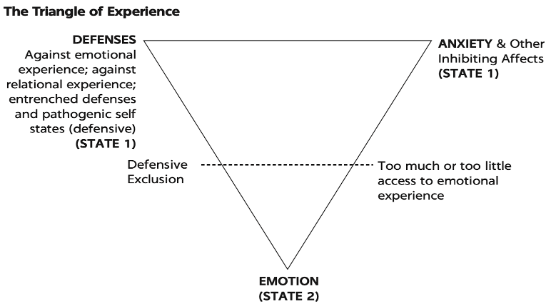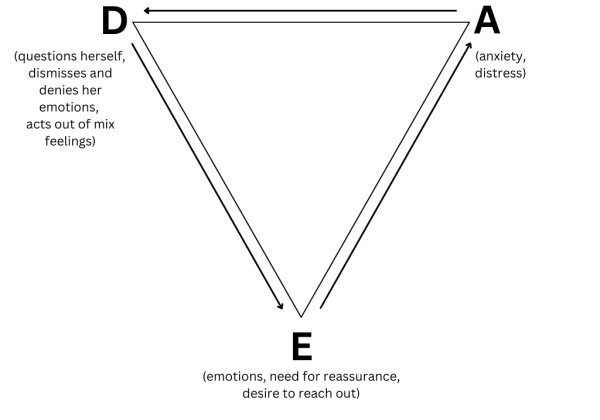This is the first instalment of a 3-part series in which we look at the Triangle of Experience tool and how it can help us make sense of our emotions.
Subscribe to our newsletter to have these posts delivered straight to your inbox.
Part 1
Feelings & Emotions
When it comes to simple tools that demonstrate the best ways to help us change our approach to our emotions, the Triangle of Experience has to rank as one of the most simple and effective.

Developed many years ago, it’s a tool that offers a graphic depiction of our internal working models for dealing with emotion in relationships. The inverted triangle illustrates what happens when anxiety provoking feelings, needs or desires are activated inside us, shining a light of awareness on what’s going on behind the scenes.
The tool’s power lies in how it clearly identifies and distinguishes the main aspects of people’s emotional experience and shows how they relate to each other. With this information, we can better understand our emotional struggles and overcome the fear we may have of certain feelings, giving us a lens through which we can step back and observe what’s happening for us moment-to-moment.
Each corner of the triangle represents one of the three main components of our emotional experience – our emotions, anxiety and defenses. These are all elements of our experience that we need to be on the lookout for and able to identify.
At the bottom of the triangle is our core feelings. Placing these at the bottom makes sense as our emotional truth often resides deep inside us and rises from our core – from the bottom up, so to speak. It also highlights the innate, wired-in aspect of our emotions and needs for connection, love and safety.
Feelings are the starting point of any emotional experience. In relationships, these feelings can be triggered by pretty much anything – a thought we have about our partner, a comment they make about us, a look they give us, the tone of voice they use when talking to us, a lack of response from them when we try to connect with them, or our partner reacting with indifference to something we say or do. Anything that gets our attention and evokes an emotional response is a feeling to be noted at the bottom of the triangle.
If it’s an emotion, need, or desire that we’ve learned to fear, our amygdala — the fear center of our brain — sounds an alarm that we’re in danger. Our nervous system moves into gear, making us feel uncomfortable — the Anxiety corner of the triangle — and prompts us to do something to get away from our feelings — the Defense corner of the triangle. We’ll look at the top corners of the Triangle in future articles.
Staying with the emotions part of the triangle, we can use an example of Sophie to illustrate how the tool works.
Sophie’s Emotional Dynamics

Sophie experiences a wave of fear and a sick feeling in her stomach when she is triggered by her partner’s indifferent reaction to her suggestion that they go check out a new apartment together. Her feelings of fear are accompanied by a need for comfort and reassurance from her partner that his indifference is not a sign of problems in their relationship. These feelings and emotions are depicted at the bottom point of Sophie’s emotional dynamics triangle. Sophie then starts to question herself and dismisses and denies her feelings. These behaviors are all defenses. She’s defending against the discomfort the emergence of her core feelings are prompting.
It’s important to recognize that the ways that Sophie acts out are not her core feelings. They are defenses against her core emotional experience of feeling afraid and desiring reassurance, connection and closeness.
The Triangle reveals the patterns that we get caught in when a core feeling starts to arise in us. The tool can be used as a frame of reference to help us make sense of our emotional experience. By being aware that something is happening and the different elements that are at hand is a crucial component of emotional mindfulness.
No body, no feelings
Feelings make their presence known through energy, sensations and visceral reactions that all register in our bodies. Put simply, if we didn’t have a body, we wouldn’t have feelings. Becoming aware of our feelings starts with noticing what’s going on in our bodies, because that’s where our feelings show up. Mindfully tuning-in to bodily sensations increases our conscious awareness of our feelings, bringing our attention to important information and helping to reveal our core emotional experience.
However, many of us simply don’t pay attention to what’s going on inside of us. We’re alienated from our felt experience and that causes problems, because when we’re not aware, we’re completely at the mercy of our faulty wiring. We just end up repeating the same old patterns over and over. Patterns that don’t get us anywhere helpful. By growing our awareness, and tuning in to our internal experience, we can recognize when we’ve been triggered and are having feelings, and we can begin to turn things around. We can start to do what needs to be done when we get triggered.
So, what should we do when we realize that we’re triggered?
The answer is precisely nothing.
Well, not exactly nothing. More like stopping and staying with what’s going on inside of us. In other words, we should allow our emotional experience to be present and felt, without responding or doing anything about it. It’s an approach that interrupts the usual chain reaction and establishes a new way of being. It stretches the distance between stimulus and response so that we can have more room for a different way of reacting. It’s easier said than done, of course, but with practice we can get better at slowing down our reactions and open up to other options. Doing so helps to update our brain’s wiring and free ourselves up for something better.
EXERCISE:
Think of a recent emotional experience that was challenging for you. Then, sketch out an upside-down triangle on a piece of paper and try to map out the different elements of your emotional experience. At this point in our process, we’re going to focus just on the bottom of the triangle, our core feelings. Try to identify what feelings were coming up for you. Were you feeling angry, afraid, sad, or ashamed? Give yourself some time to try to get at what was going on deep inside of you. Maybe it will be apparent. Maybe it will be unclear. That’s alright. As you work the triangle and focus more on your felt experience, you’ll be better able to identify your core feelings. Start with the feelings on the bottom point of the shape, noting when you have them and what that is typically like for you. Perhaps you’ll start to get a picture of what it’s like when you get triggered. As you’ll come to see, getting triggered means you’re likely experiencing feelings, needs or desires that you feel conflicted about. The conflict part of your experiences is on the top of the triangle. We’ll get onto what to put on those other corners of the Triangle of Experience in the next two articles.
Using my four-step process will help you better recognize your core emotional experience as it emerges. You can discover more about these steps in my books Loving Like You Mean It and Living Like You Mean It.

